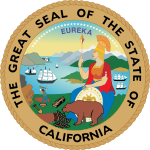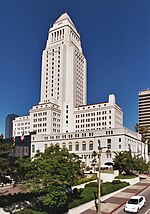
The mayor of Los Angeles is the head of the executive branch of the government of Los Angeles and the chief executive of Los Angeles. The office is officially nonpartisan, a change made in the 1909 charter; previously, both the elections and the office were partisan.

The 2005 Los Angeles mayoral election took place on March 8, 2005, with a run-off election on May 17, 2005. In a rematch of the 2001 election, Councilman Antonio Villaraigosa defeated the sitting mayor, James Hahn, becoming the city's first Hispanic mayor since the 19th century.

Guy Vernon Bennett was superintendent of schools in Pomona, a professor of education at the University of Southern California, and a Los Angeles city councilman from the 10th District from 1935 to 1951. He was defeated for reelection after seventeen years in office in the wake of his arrest on a morals charge. He was a Democrat.

Thomas Lee Woolwine was an American lawyer and politician who served as the 27th District Attorney of Los Angeles County between 1915 and 1923. He began his career as a Deputy District Attorney in 1908. Woolwine was the Democratic nominee for Governor of California in the 1922 general election, but lost to Friend Richardson. In 1923, he resigned as District Attorney and was succeeded by Asa Keyes.

The 1993 Los Angeles mayoral election took place on April 20, 1993, with a run-off election on June 8, 1993. This was the first race in 64 years that an incumbent was not on the ballot. It marked the first time in 24 years that retiring Mayor Tom Bradley was not on the ballot, after five consecutive victories starting in 1973. Richard Riordan became the first Republican mayor elected in 36 years.

A 2011 special election filled the vacancy in California's 36th congressional district after the resignation of incumbent Jane Harman on February 28, 2011; Harman vacated her seat in the U.S. House of Representatives to become head of the Woodrow Wilson International Center for Scholars.

The 1929 Los Angeles mayoral election took place on June 9, 1929. Incumbent George E. Cryer chose not contest the election and retire from office, making it the first open seat since 1911. The race was won by John Clinton Porter, who defeated Councilman William G. Bonelli, John R. Quinn, and 11 other candidates.

The 1933 Los Angeles mayoral election took place on May 2, 1933, with a run-off election on June 6, 1933. Incumbent John Clinton Porter was defeated by Frank L. Shaw, a Los Angeles County Supervisor, in the runoff election. During the election, Shaw's citizenship was questions as his birth records could not be located.

The 1937 Los Angeles mayoral election took place on April 6, 1937, with a runoff election on May 4, 1937. Incumbent Frank L. Shaw was reelected over Supervisor John Anson Ford in the runoff election.

The 1938 Los Angeles mayoral recall election took place on September 16, 1938 following the recall of incumbent Frank L. Shaw. Shaw was defeated by Fletcher Bowron in the election, making him the first recalled mayor in American history.

The 1941 Los Angeles mayoral election took place on April 1, 1941, with a run-off election on May 6, 1941. Incumbent Fletcher Bowron was re-elected in the runoff election, defeating councilmember Stephen W. Cunningham.

The 1949 Los Angeles mayoral election took place on April 5, 1949, with a run-off election on May 31, 1949. Incumbent Fletcher Bowron was re-elected.

The 1953 Los Angeles mayoral election took place on April 7, 1953, with a run-off election on May 26, 1953. Incumbent Fletcher Bowron was defeated by Norris Poulson, a U.S. Representative.

The 1961 Los Angeles mayoral election took place on April 4, 1961, with a runoff election on May 31, 1961. Incumbent Norris Poulson was defeated by Sam Yorty, a former U.S. Representative.

The 1977 Los Angeles mayoral election took place on April 5, 1977. Incumbent Tom Bradley was re-elected over nine other candidates. He was mainly challenged by State Senator Alan Robbins and tax policy activist Howard Jarvis, with Robbins campaigning on his opposition to busing in the city. Bradley was widely expected to easily win re-election, and on election day, Bradley won by a landslide against the other candidates.

The 1981 Los Angeles mayoral election took place on April 7, 1981. Incumbent Tom Bradley was re-elected over former Mayor Sam Yorty. The election was a third rematch between Bradley and Yorty, the other two being in 1969 and 1973. It would be the last time a Mayor would be elected to a third term, as voters amended the city charter in 1993 to implement a two-term limit for the office of Mayor.

The 2004 San Diego mayoral election was held on Tuesday, November 2, 2004 to elect the mayor for San Diego. Incumbent mayor Dick Murphy stood for reelection for a second term.

The 2000 San Diego mayoral election was held on Tuesday, November 7, 2000 to elect the mayor for San Diego. Incumbent mayor Susan Golding was ineligible to run for reelection due to term limits.

On July 22,1916 William Stephens (Progressive) resigned to become Lieutenant Governor of California, after the former Lieutenant Governor died in office. In order to fill the gap left in his absence, a special election was held to fill the position for the duration of the term.

Carl Bernardino Wirsching was an American engineer, veteran, and politician who was active in Los Angeles in the 1930s and 1940s. After serving in the United States Army as a part of the American Expeditionary Forces in France, he returned to Los Angeles to pursue political activities, running in the 1937 Los Angeles mayoral election and placing fourth in the primary.













